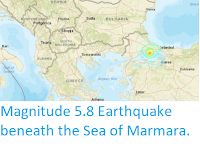The United States Geological Survey
recorded a Magnitude 6.7 Earthquake at a depth of 10 km, about 4 km to
the northeast of the city of Doğanyol in Malatya Province, southeast Turkey, at about 8.55 pm local time (at about 5.55 pm GMT) on Friday 24 January 2020. The Earthquake is reported to have caused a number of building collapses across the area, as well as a large number of deaths and injuries. At the time of writing 22 people are known to have died due to the Earthquake, four in Malatya Province and eighteen in Elazığ Province, with more than 1200 people injured, though these figures are expected to rise further as the rubble from collapsed buildings is cleared. The Earthquake was felt across eastern and central Turkey, as well as in Georgia, Iran, Iraq, Syria, Lebanon, Jordan and Israel.
Collapsed buildings in eastern Turkey following a Magnitude 6.7 Earthquake on Friday 24 January 2020. Hürriyet Daily News.
Malatya Province lies at the boundary between the Eurasian Plate to the
north and east, the Anatolian Plate to the west and the Arabian Plate to
the south. The Arabian Plate is being pushed north and west by the
movement
of the African Plate, further to the south. This leads to a zone of
tectonic activity within the province, as the Arabian and Anatolian
plates are pushed
together, along the East Anatolian Fault, and past one-another, along
the Dead Sea Transform.
The approximate location of the 24 January 2020 Malatya Province Earthquake. USGS.
This movement also leads to a zone of faulting along the northern part
of Turkey, the North Anatolian Fault Zone, as the Anatolian Plate is
pushed past the Eurasian Plate, which underlies the Black Sea and
Crimean Peninsula (transform faulting). This is not a simple process,
as the two plates constantly stick together, then break apart as the
pressure builds up, leading to Earthquakes, which can be some distance
from the actual fault zone.
The northward movement of the African and Arabian Plates also causes
folding and uplift in the Caucasus Mountains, which separate Georgia
from Russia. Again this is not a smooth process, with the rocks sticking
together, then moving sharply as the pressure builds up enough to break
them apart, which can also lead to Earthquakes in the region.
Plate movements and fault zones around the Anatolian Plate. Mike Norton/Wikimedia Commons.
Witness
accounts of Earthquakes can help geologists to understand these events,
and the structures that cause them. The international non-profit
organisation Earthquake Report is interested in hearing from people who may have felt this event; if you felt this quake then you can report it to Earthquake Report here.
See also...
Follow Sciency Thoughts on Facebook.









